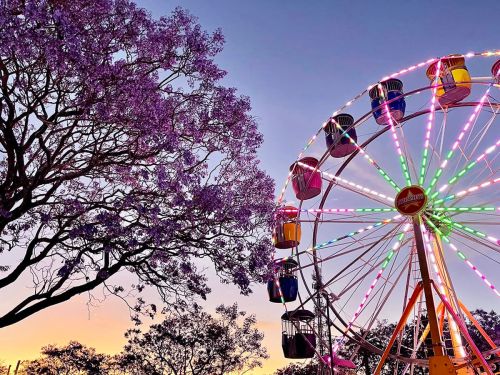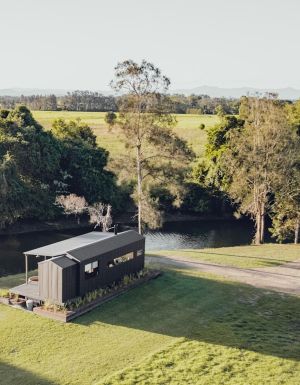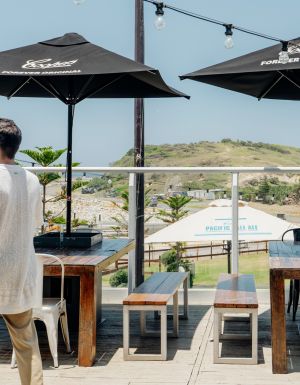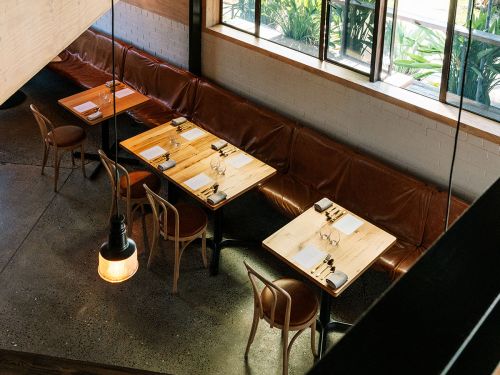Every spring, Grafton’s streets are plunged into a purple paradise by its iconic jacaranda trees. This year the season culminates in 90 years of the city’s famous Jacaranda Festival.
To see Grafton’s jacaranda trees in bloom is to see a town transformed almost overnight. For just a few short weeks each spring, clusters of lilac bell-shaped blooms unfurl and stretch out lazily across the branches of the town’s jacaranda trees, shrouding the streets in a purple haze. Not only does Grafton then emerge as one of the most enchanting places in Australia, but it’s also proudly home to the famous Jacaranda Festival .
This year, the festival celebrates its 90th anniversary. What began as a small act of civic pride among locals is now regarded as the country’s longest-running and most beautiful floral festival, capturing the romance of regional living and celebrating a unique tree like no other.

A verdant history
The first of Grafton’s iconic jacaranda trees were planted in the 1880s as part of a town beautification project. They’ve since become a much-celebrated tourist attraction, with many of the 1700 heavily scented jacarandas reaching well over 100 years old.
Grafton Jacaranda Festival highlights
For its 90th birthday this year, the festival is celebrating with a dynamic lineup of performances, parades and parties, not to mention market stalls, rides and live entertainment.
Food is front and centre, so expect a showcase of the best Clarence Valley produce, as well as the CHS Training Blossom Wine & Dine Long Lunch , which takes place outdoors under the purple canopy. There’s also the country-style Whiddon Jacaranda Afternoon Tea , as well as a variety of food trucks located in and around festival hubs.
Traditionally, the Clarence River marks the boundary between the Bundjalung and Gumbaynggirr people. Along with the Yaegl people, the three Traditional Custodians of the Clarence Valley will come together for a day of shared culture, performance, music and dance as part of the River Dreaming program. The Women of Song music event also features First Nations Choral Group performances.

Stay overnight and you’ll get a chance to see the jacaranda trees illuminated in See Park . Here, some of the city’s best jacaranda canopies are lit up at night, juxtaposing the vibrant purple against the night sky and reflecting on the park’s water features.
There’s plenty for kids, too. Along with the Friday night fireworks, the festival kicks off with the Children’s Party, featuring dress-ups, food trucks and games for kids. Carnival Capers, held in South Grafton, has free family entertainment. There’s also a free community breakfast held in Market Square.
One of the best ways to experience the festival is on a bus tour, which will take you to all the hotspots around town and South Grafton. You can also choose to take a hop-on, hop-off bus service around the hubs and events.

Why not stay a little longer?
While the jacarandas take all the attention, Grafton is also home to one of Australia’s most important regional art prizes: the Jacaranda Acquisitive Drawing Award (JADA). Shown at the Grafton Regional Gallery , the competition attracts some of Australia’s premier artists, and entries are exhibited during the festival.
The Grafton Heritage Trail showcases the best of the city’s Edwardian and Victorian architecture, including the National Trust-listed Schaeffer House ; now a museum, it was built in 1901 by local architect F.W.C Schaeffer, who helped shape the area. Just outside town you’ll also find the quirky Remember When Cottage Museum , a historic building fitted out with memorabilia from life in the Clarence Valley.

It’s also worth stopping by Grafton’s iconic “bendy" bridge, a double-decker bascule truss bridge, built with a bend on either approach for vehicles to accommodate the rail line. Part of the heritage walking trail and best experienced on foot, the purple flowers reflect brilliantly on the Clarence River below when the winds are still, then dot the river in flecks of mauve when a breeze appears.
The Clarence Valley region is the perfect place for a road trip. Drop a line at the mouth of the Clarence River at Iluka, surf Yamba’s iconic break, visit the historic river town of Maclean with its Scottish heritage, or take to the waterways on the spectacular 195-kilometre Clarence Canoe and Kayak trail . Then, stay a night or two in any one of the numerous caravan parks, cosy pubs, boutique hotels, retro motels or private rural properties dotted around the area.















